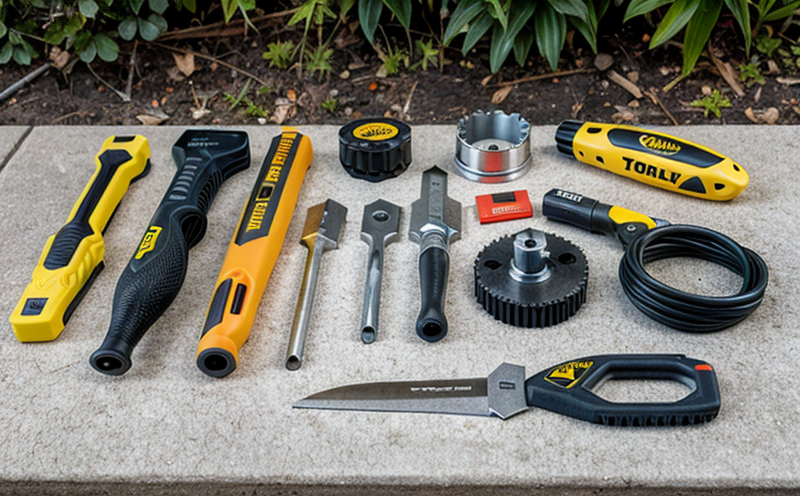Motor Performance Testing in Power Tools
Motor performance testing is a critical component of ensuring safety and reliability in power tools. This service involves rigorous examination and evaluation of motors used in various types of power tools to ensure they meet the necessary performance, durability, and safety standards. For quality managers and compliance officers, this process ensures that products are safe for consumer use, while R&D engineers can leverage these tests to refine designs and improve efficiency.
Motor performance testing typically includes a series of tests designed to assess the motor's ability to operate under various conditions. These tests may include load torque measurement, speed regulation, power consumption, and temperature rise checks. The purpose is to ensure that the motor operates efficiently without overheating or failing under normal operating conditions.
The specimens used in these tests are usually the motors themselves, taken directly from the manufactured tools. Proper specimen preparation is crucial to obtaining accurate results. This involves cleaning the motor, ensuring it is free of contaminants, and calibrating any measurement devices used during testing. Once prepared, the motors undergo a series of performance checks.
Instrumentation plays a vital role in this process. High-precision torque meters and data loggers are often used to monitor load conditions, while thermocouples measure temperature changes. Speed sensors help gauge motor speed under different loads, providing critical insights into its operational efficiency.
The final step involves generating detailed reports that document the performance metrics of each tested motor. These reports serve as a benchmark for quality control and can be used by R&D engineers to make informed decisions about design improvements or necessary adjustments in manufacturing processes.
- Load torque measurement
- Speed regulation evaluation
- Power consumption analysis
- Temperature rise checks
By adhering to international standards such as ISO, ASTM, and EN, we ensure that our testing methods are consistent with industry best practices. This guarantees accurate results and builds trust among clients.
In summary, motor performance testing is an essential part of the product development lifecycle for manufacturers in the DIY tools sector. It helps identify potential issues early on, ensuring products meet regulatory requirements and exceed customer expectations regarding reliability and safety.
Applied Standards
The International Organization for Standardization (ISO), American Society for Testing Materials (ASTM), European Committee for Standardization (CEN), and International Electrotechnical Commission (IEC) all provide relevant standards that guide motor performance testing in power tools.
- ISO 85721:2019 – This standard specifies the methods for measuring torque, speed, efficiency, and other parameters of electric motors used in power tools. It ensures consistency across different manufacturers and regions.
- ASTM D3426-18 – Focuses on determining the electrical characteristics of small motors, which can be applicable to certain types of power tools.
- CEN/TS 15970:2005 – Provides guidelines for testing electric motors in corded and battery-powered hand tools. This includes tests related to vibration, noise level, and durability under specified conditions.
- IEC 60312-2:2008 – Covers the requirements for small household appliances, which often include power tool components like motors.
These standards ensure that motor performance testing is conducted in a standardized manner, leading to more reliable and consistent results. Compliance with these standards also helps manufacturers meet regulatory requirements globally.
Quality and Reliability Assurance
- Consistent Testing Procedures: Our laboratory follows strict procedures for testing motors in power tools, ensuring that every motor undergoes the same rigorous evaluation process. This consistency helps maintain high-quality standards throughout our testing.
- Data Accuracy: Advanced instrumentation and data logging systems guarantee accurate measurement of key performance indicators such as torque, speed, and efficiency. These precise measurements form the basis for reliable conclusions regarding motor quality.
- Regular Calibration: All testing equipment is regularly calibrated to maintain accuracy over time. This ensures that our results remain trustworthy and dependable.
- Compliance Verification: Every test result must comply with relevant international standards like ISO, ASTM, EN, and IEC. Any deviation from these standards is flagged for review by our technical team.
Our commitment to quality assurance goes beyond mere testing; it encompasses every aspect of the process, from initial setup through final reporting. By adhering strictly to these protocols, we ensure that our clients receive accurate and reliable information about their products' performance capabilities.
International Acceptance and Recognition
The results of motor performance testing conducted by our laboratory are widely recognized across the global market. Our compliance with international standards such as ISO, ASTM, EN, and IEC ensures that the tests are accepted in numerous countries around the world.
- United States: Compliance with ASTM D3426-18 is particularly important for companies operating within U.S. borders. This standard helps ensure product safety and performance meet American regulatory requirements.
- European Union: Products tested against EN standards, including CEN/TS 15970:2005, are more likely to gain acceptance in EU markets due to the harmonization of these regulations among member states.
- Japan and Asia-Pacific Region: ISO standards like ISO 85721-1:2019 have significant relevance here as well. These standards help manufacturers align their products with local and regional specifications, enhancing market access opportunities.
The recognition of our test results by these international bodies adds value to the reputation of both individual companies and entire industries operating within those regions. It provides a level of assurance that the tested motors meet stringent quality and safety criteria.





